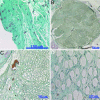Biomimetic tissue-engineered anterior cruciate ligament replacement
- PMID: 17360607
- PMCID: PMC1805619
- DOI: 10.1073/pnas.0608837104
Biomimetic tissue-engineered anterior cruciate ligament replacement
Abstract
There are >200,000 anterior cruciate ligament (ACL) ruptures each year in the United States, and, due to the poor healing properties of the ACL, surgical reconstruction with autograft or allograft tissue is the current treatment of these injuries. To regenerate the ACL, the ideal matrix should be biodegradable, porous, and exhibit sufficient mechanical strength to allow formation of neoligament tissue. Researchers have developed ACL scaffolds with collagen fibers, silk, biodegradable polymers, and composites with limited success. Our group has developed a biomimetic ligament replacement by using 3D braiding technology. In this preliminary in vivo rabbit model study for ACL reconstruction, the histological and mechanical evaluation demonstrated excellent healing and regeneration with our cell-seeded, tissue-engineered ligament replacement.
Conflict of interest statement
The authors declare no conflict of interest.
Figures




References
-
- Dunn MG, Tria AJ, Kato YP, Bechler JR, Ochner RS, Zawadsky JP, Silver FH. Am J Sports Med. 1992;20:507–515. - PubMed
-
- Wise DL, Trantolo DJ, Altobelli DE, Yaszemski MJ, Gresser JD, Schwartz ER. Encyclopedic Handbook of Biomaterials and Bioengineering. New York: Dekker; 1995. Part A: Materials.
-
- Altman GH, Horan RL, Lu HH, Moreau J, Martin I, Richmond JC, Kaplan DL. Biomaterials. 2002;23:4131–4141. - PubMed
-
- Yahia L. Ligaments and Ligamentoplasties. New York: Springer; 1997.
-
- Guidoin MF, Marois Y, Bejui J, Poddevin N, King MW, Guidoin R. Biomaterials. 2000;21:2461–2474. - PubMed
Publication types
MeSH terms
Substances
Grants and funding
LinkOut - more resources
Full Text Sources
Other Literature Sources

